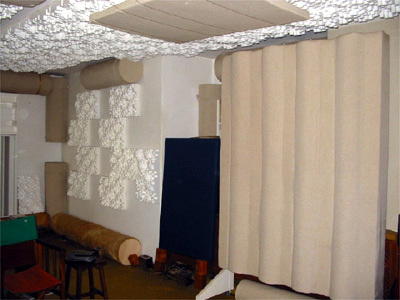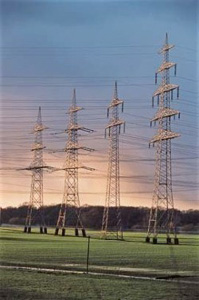|
OPTIMIZING A SOUND SYSTEM
Part
3:
After
Acoustics,
what comes next?
Jorge
Knirsch
Introduction
In
this
series of articles
we intend to analyze the basic aspects involved in the electronic
reproduction of music. To that end, we include
factors
such as the room, the
power line and grounding,
besides the equipment itself
. Our ultimate goal is to
provide you with some additional tools in order
for you optimize
your own sound systems, therefore raising the level of music
reproduction.
In
the
first two
parts of this series we dealt with the factor that most influences sound
reproduction, though in quite
encompassing a
way – the room. We have said that since a large number of our rooms
are
small, the influence they bring about
in the final results
ranges from 50 to
80
per cent, regardless of the equipment we may
be using. In a small room we would in
no way manage to
obtain sound quality to
such
high standards, even by using the “best
equipment in the world”. We
could invest heavily in equipment
but even
then we wouldn’t reach the desired sound. This is because the acoustic
treatment is decisive for
obtaining
the final results
in
small rooms. It took me 19 years as
an
audiophile
and electronic engineer,
“brainstorming” to finally
get
“the insight” that led me to this
indisputable
fact – the room
factor is essential! I guess what had
deceived
me this
whole
time was my belief
that my room
was very well suited
to sound
reproduction.
After all,
the room
did not seem so small (it
has around 70 cubic meters)
and besides, its dimensions are
"special"
(for they
come
close to the so-called golden dimensions). However, after so many
disputes, I am now convinced that unless our rooms have appreciable
volume, say over 100 cubic meters, the negative influence it will effect
upon sound results will be damaging, for
it
will
certainly limit our systems’ performance,
and
to a large degree.
Nevertheless, to treat a
room acoustically is not to place foam pieces here and there. It is
necessary to carry out a deeper study on the reflective surfaces (room
walls), by means of several acoustic measurements, in order to evaluate
the room's flaws.
From this point on,
in
some specific areas, there will probably
be the need to place
suitable materials in order
to absorb sound waves. Yet on other areas maybe
sound waves need to be
spread (reflected) or, who knows,
maybe they need to
be refracted (modified in their form and
then reflected). I
recommend you get
advise
from
a reputable acoustic engineer for such work.
You will
obtain better results
this way. And it
is interesting that
after
having treated the room, even medium-grade electronic equipment
will give surprising
and pleasing sound
results. And besides
better sound results, it is also much cheaper!

Our Laboratory some time ago.
In
the two last articles I gave you some basic concepts that should guide
the acoustic treatment of your room.
Briefly,
I wish to point out here the four acoustic waveforms we may find in a
room:
© 2004-2008 Jorge Bruno Fritz Knirsch
Todos os direitos reservados
http://www.byknirsch.com.br
The Four Acoustic
Waves
Direct Waves – These are the ones that leave loudspeakers
without reflections from any of the room’s walls
and hit the
listener directly. These are the most important waves in order
for one to have
good sound reproduction.
First Reflections – These are the waves that come out of the
loudspeakers and having been reflected
by one
of the walls, hit the
listener.
Therefore, these are the waves that hit the listener immediately after
direct waves, just after a short span, getting
blended
with direct waves. These are very harmful to the final result, mainly in
small rooms, for they degrade soundstaging, tonal balance and
the
reproduction's
organic character. An observation: in order not to reinforce such first
reflections, don’t place loudspeakers too close to the walls.
Reverberating Waves – These
are waves that hit the listener
after having been reflected a
number of times between the walls. These waves
create a diffused sound, removing sharpness from what's
heard. They are very harmful in auditoriums and theaters, but in small
rooms, moderate reverberating fields may even help soundstage formation.
These waves bring volume to sound, allowing equipment to work at lower
volumes.
Standing Waves
– These are
created by many reflections from low frequency waves. The room modes are
created by the dimensions of the room. Smaller rooms has greater
problems with room modes. Both
the
loudspeaker's
position as well as the listener’s, can attenuate the influence of the standing
waves. These waves must be reduced or if possible eliminated by specific absorbers, such as
the panel absorbers or Helmholtz absorbers.
Let us now
move on to the second most important factor
in
the rank of influence
regarding
sound reproduction.
The Second Factor
This second factor that influences sound reproduction
will certainly generate much debate
because it is not readily apparent. It manages to confuse some
people a lot, and to fully misguide
others. Few sound
equipment manufacturers take it seriously, but mainly in the
“high-end”, there are those that have already recognized it as being
the most important success factor for the electronic part of appliances
when analyzed correctly. Some of you, perhaps intuitively, may have
already discovered what it is. But let’s look at it
!!
Let
us
look at some situations which
may occur. Who knows,
maybe you are
going to realize
that
you've already faced some of these
situations or perhaps you have already
overheard something
like this happening to others.
A certain day,
one of those heavily-charged ones,
having
left
work earlier and
still on office hours, you come home tired and
in
need
of
a moment
to unwind and
relax…
has this ever happened to you? You switch on your
sound equipment
for one moment before you
leave for one more appointment and… something
calls
your attention: the equipment is playing a CD section you know well.
When you go
back to
a section
you
confirm that a certain detail of the song really sounds to you
to be
at
a volume
lower
than
usual. How strange!
Why would
it be
playing at lower intensity, if you did not touch the volume knob? You
sit down to listen more carefully, realizing
that
all the sound is
in fact
different, more
flattened, with noticeable soundstage loss. What's
going on?
Maybe
somebody
touched the wiring? You
come closer to
the equipment,
to have a
look at it, check
it out, but everything
is exactly the same
way you had left it the night before. Maybe
it's
that the
background noise at night gets
lower and the environment
becomes
much more silent so that
aural perception becomes acuter
than during daytime? The fact is that you are puzzled, but you don’t
find a reasonable explanations
for what is happening!
Another situation, perhaps somewhat unusual, is when you and your
friend, a
fellow
audiophile, have exactly the same equipment
- preamp, power amp,
cables, everything the same, similar rooms, both
untreated
acoustically, but for some
unexplainable reason,
the
sound at
your friend’s is a little
better than yours. And of course, this can’t be a matter of misfortune,
can it? Of course not!!
And
now one more
situation: let's now
suppose that you have moved to a new home. After having set up all your
equipment (absolutely the same
as that from the
old house) in the new room which
has dimensions similar to the old one, or even a tad larger than the old
room’s dimensions, you switch on the sound and get scared at the results
– it is much worse than the one at the old house!! It seems absurd! The
sound seems more flattened and your realize there is more grain on the
song’s notes. What's going on? You check all connections
to make sure
everything
is
correctly
connected. You get puzzled
and have no explanations for
this.
Some weeks
later you realize
one more interesting difference: all appliances work at higher
temperatures than they did at the old house. They are now some degrees
Celsius hotter than before. Why? What's happening?

Conclusion
The origin of
all the above-mentioned problems
no doubt lies in the electric energy
we get
at
our homes. It is the reason our system reproduces much better at
night than during the
daytime. In fact, it is the one
factor that
causes
temperature differences
in equipment,
depending on the place
where
they are switched on. We
are going to have a
deeper
look at this in
coming articles. It is important to stress that the more “high-end” our
equipment
is,
the more apparent the negative influence from the power line becomes.
Electric energy
comes from our homes’ outlets in the form of a sinusoidal voltage, at
60Hz frequency. As you know, there are several voltage levels, such as
110V (now
becoming out of use), 115, 120, 127V.
In Brazil, there is also
220 and 230V between phase and neutral,
or between phase and phase as well. It happens that lots of unwanted
things come
along with this voltage, such as harmonics
and transients (also called “spikes”), that degrade our sound. But let's
follow up this talk at
another opportunity.
I want to mention here another two very important factors, not
necessarily correlated to electric energy, but very relevant also
to
a sound system: grounding and those vibrations acting upon equipment. My
previous research
show
very large influence of the grounding over
the
systems’ tonal balance,
a fact that startled me, since grounding is a practice totally left
out
in Brazil.
Well, we have
much to talk about with
you.
In
the next part of this article we will talk about electrical energy, its
evils and the way we can avoid them. After this, we intend to talk about
grounding and anti-vibration systems.
Cheers to all, and… good listening!
Back
 -
PRODUTOS, PROJETOS E INSTALAÇÕES -
PRODUTOS, PROJETOS E INSTALAÇÕES
|